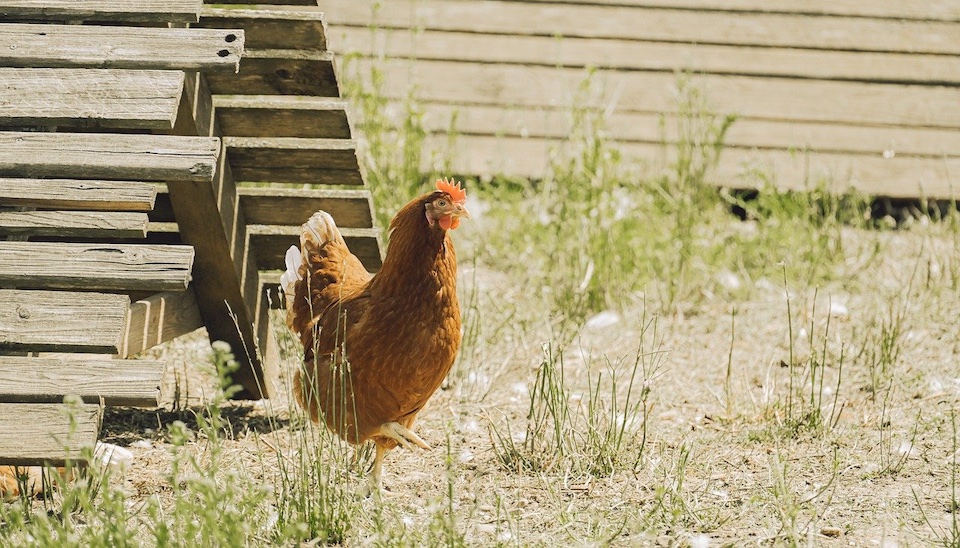Where to put a chicken coop in your backyard
Choosing the best spot for your chicken coop
If you are just getting chickens, you have a wonderful journey in front of you. In addition to providing fresh, healthy eggs, and manure for the garden, and pest control, and weed management, and waste disposal, chickens also make great pets. Did we mention that we love keeping chickens!
If you are getting chickens for the first time, you might be looking at building a chicken coop. We have lots of articles to help you on our blog.
But the first thing you need to decide is where to put the chicken coop. Choosing the best place for your chicken coop will make chicken keeping easier and more fun.
Where to put your chicken coop
The best place for a chicken coop in your backyard will be different from the best place in my yard, or even in your neighbour's yard. This is because every backyard is different and you will have different things to work around, like trees and buildings. Even the type of coop you choose will influence where you should put it.
In order to help you choose the best place for your chicken coop, we have broken down the planning into 3 sections. Work through the sections in order to choose the best place for a chicken coop in your yard.
In short, you want a sunny, sheltered, well-drained spot that isn't too far from the house and that avoids gardens and play areas. Read on to learn more.
Part 1: What type of coop is best?
You have multiple options for keeping your chickens safe. The type of coop system you choose influences where you should put the chicken coop in your yard.
Chicken coop only
Yes, you can keep chickens confined to a chicken coop.
But to be happy, chickens need plenty of room to move around and things to interest them. If they are confined to the coop 24/7, the more coop-space, the better. Click here for more on chicken coop size.
Bullying and other stress-behaviours are common in confined flocks. Green forage and toys can help, but providing more space and room to forage is usually a better option.
Chicken coop and run
Most chicken keepers choose to have a coop and a run. A chicken run is a fenced-off area where the chickens are able to free-range. The coop provides shelter, while the run provides space to forage.
There are many benefits to having a coop and run. The coop can be much smaller. Good runs provide chickens with room to move and protection from predators. Runs also keep chickens out of areas where you don't want them, such as gardens.
When you have a coop and a run, space in the coop can be less than 1 m square per chicken, but run space should be at least 3 m square per bird. This option requires more space than just a coop, but your chickens will thank you. And so will your gardens and neighbours!
Most runs are permanent, so where you put them is important. Chickens can cause damage to plants. In small runs, they may eventually turn it into dirt. Even in larger runs, a dirt patch in front of the coop is common. For this reason, chicken runs should avoid precious plants, even fruit trees, as well as areas where erosion is an issue.
Some chicken keepers have multiple runs to allow plants to recover. A better option these days is electric poultry fencing, which can be used to make a moveable run.
Chicken tractor
Chicken tractors are moveable coops. Although there are mammoth versions for pastured egg farmers, most chicken tractors you can buy are very small and best suited to 2-3 small chickens, such as silkies.
Chicken tractors are moved every 1-3 days to give chickens access to new ground. They work well on lawns or in gardens, where chickens can be used to prepare beds for planting.
Although chicken tractors don't take up much space, you will need room to move the tractor 10-30 times before returning to the first spot or your plants will suffer.
Completely free-range chickens
Chickens can be completely free-range and sleep in trees. But they won't have a very long life expectancy, due to predators.
Most chicken keepers who let their flock free-range still have a small chicken coop. Chickens can roam up to a kilometre from the coop, so this option only works on rural blocks.
Free-ranging, unconfined chickens can damage trees and mess up mulch and gardens. They also have a tendency to hang out and poo on verandas.
Part 2: Things to avoid with your chicken coop
In a lot of suburban yards, you won’t have a lot of options for where to put your chicken coop. This is especially the case if you need a large coop and run.
But it is still worth considering the things you need to avoid when situating your chicken coop
Don’t break council regulations
Some local councils have laws about how close a chicken coop can be to your boundary or house. Some areas also have different laws depending on if you are near a school or other public space, so check with your council first.
Your neighbours
Even if your council doesn’t specify, keeping chickens away from your neighbours is the considerate thing to do!
Chickens can be noisy, especially if you have a rooster. You don't want the coop right next to the house, and neither do your neighbours. Nobody wants someone else's chickens messing up their garden, either!
Other things in the yard
Here are a few things that should not be inside the coop or run:
- Gardens, including the veggie patch, flowers and herbs
- Children’s play areas (cubbies, lawns, sandpits etc.)
- Fruiting plants where chickens can reach the fruit, e.g. blueberries, or where you don’t want chickens to eat fallen fruit, e.g. passionfruit
- Compost bins
- Outdoor entertainment areas and verandas
- Steep slopes or any other area where erosion is an issue
- Damp areas such as drainage ditches
- Young trees or those with delicate root systems (without protection, anyway)
Your house
Although watching your chickens forage from the veranda is lovely, most people don't appreciate their chickens pooing on the veranda!
There are other reasons why the chicken coop should be at least a few metres from the house: while unlikely, parasites like bird mites and lice, can spread a couple of metres if left untreated; plus chickens can be noisy!
Ideally, you want the coop just close enough to benefit from your protection in the case of a predator, and so it is easy to visit a couple times a day.
Part 3: The best chicken coop site - environmental factors
Although you might not have a lot of options, once you’ve avoided houses and neighbours, most people have some choice when situating their chicken coop.
Here is what you should look for when choosing the best place for your chicken coop:
Sunlight
Sunlight helps keep things dry and kills many diseases and parasites. Your chickens will also love dust bathing and preening in the sun!
Ideally, you want winter sun and summer shade for the coop itself. Under a deciduous tree works well. The run should have as much sunlight as possible to prevent mud.
Shade
Chickens do suffer in the heat, and lay fewer eggs. So if you are in a warm part of Australia (most of the mainland), you should make sure there is plenty of good, dense shade for summer.
A shady coop for summer is more important than having winter sun. Shade in the run is less important, as it is easy and cheap to create shade if you need it.
Dry ground
The last thing you want is a wet, muddy chicken coop or run.
Place your coop in the driest area possible, ideally with a small slope so water will run off. Sunlight will also help keep the ground dry! Here are some other tips for preventing a muddy run.
So where should I put my chicken coop?
Ultimately, you should put your chicken coop:
- Close to the house, so it is easy to visit and monitor
- Not too close to the house, to avoid noise, smells and parasites
- Away from the neighbours
- Where chickens have sufficient room (in a run, free-ranging or in a chicken tractor)
- Away from children's play areas
- So that your chickens cannot access or damage gardens and delicate plants
- In a sunny position with summer shade
- Away from erosion sites
- In a well-drained area, such as on a small slope
For more information to help you design and build a chicken coop, visit these other handy blog articles:
- Calculating chicken coop size
- Everything you need to know about chicken runs, including how to build one
- How to keep the chicken run dry
- What is the best roost for chickens
Is there something else you'd like to know? Contact us.
Happy chicken keeping!
Rachael at Dine a Chook Australia






